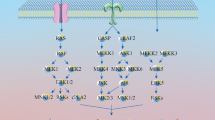Summary
This study examined the effect of saponins from Tupistra chinensis Bak (STCB) on the growth of sarcoma S-180 cells in vitro and in mouse xenografts as well as the underlying mechanisms. Cell proliferation was assessed by MTT assay. Cell cycle distribution was determined by flow cytometry. Sarcoma S-180 tumor-bearing mice were treated with different doses of STCB with 10 μg/mL 5-fluorouracil (5-Fu) as a positive control. The activity of nuclear factor (NF)-κB was detected by gel mobility shift assay. The mRNA level of NF-κB was determined by real-time quantitative RT-PCR. The results showed that in vitro STCB inhibited the growth of S-180 cells in a concentration-dependent manner, which was accompanied by cell cycle arrest at S-phase. In vivo STCB significantly inhibited the growth of S-180 tumor mouse xenografts in a dose-dependent manner with apparent induction of cell apoptosis. Moreover, STCB inhibited the activity of NF-κB p65 and reduced the expression of NF-κB p65 mRNA in mouse xenografts. It was concluded that STCB inhibits the proliferation and cell cycle progression of S-180 cells by suppressing NF-κB signaling in mouse xenografts. Our findings suggest STCB is a promising agent for the treatment of sarcoma.
Similar content being viewed by others
References
Han MX, Chen HY. Research progress on status quo of psychological distress in malignant tumor patients and its related factors. J EBN (Chinese), 2016, 2(1):1–6
Yang QC, Zhan YC, Hu ML, et al Study on pharmacognosy characteristics of Chinese herbal medicine. J Shanxi U T (Chinese), 2016, 1(2):76–81
Tang CZ, Yu L, Liu JQ, et al. Advances in studies on physiological active substances and their pharmacological actions of open arrow. J Henan Normal University (Chinese), 2016, 2(2):114–118
Huang W, He ML, Jiang MQ, et al. Total saponins of Tupistra chinensis induces apoptosis in A549 cells. Neoplasma, 2012, 59(6):613–621
Cai J, Qi HM, Liu BW, et al. Saponin from Tupistra chinensis Baker inhibits mouse sarcoma S-180 cell proliferation in vitro and implanted solid tumor growth in mice. Nan Fang Yi Ke Da Xue Xue Bao (Chinese), 2007, 27(1):188–190, 194
Xie JY, Guo W, Hu ML, et al. Study on apoptosis of tumor cell induced by saponin of Chinese herb. Pharmacol Clin, 2014, 3(2):82–86
Maniati E. Crosstalk between the canonical NFkappaB and Notch signaling pathways inhibits Ppargamma expression and promotes pancreatic cancer progression in mice. J Clin Invest, 2011, 12(1):4685–4699
Lv KJ. Expression of NF-κB and VEGF in nonsmall cell lung cancer and its relationships with tumor angiogenesis. Chin J Histochem Cytochem (Chinese), 2013, 2(2):59–62
Xie J, Zhang DD, Li YZ, et al. Study on apoptosis of tumor cells induced by Tupistra chinensis Bak. Chin Med Pharmacol Clin (Chinese), 2014, 30(3):82–86
Cheng Y, Zhang L. Progress in research on antitumor mechanism and drug of Chinese Medicine. China Pharmaceut (Chinese), 2013, 17(3):103–110
Meijerman I, Beijnen JH, Schellens JHM. Herb-drug interactions in oncology: focus on mechanisms of induction. Oncologist, 2006, 11(7):742–752
Wang JL. Computer aided virtual screening of active ingredients of antineoplastic Chinese medicine. Ocean Univer China (Chinese), 2011, 9:10–11
Prasad S. NF-kappaB and cancer: how intimate is this relationship. Mol Cell Biochem, 2010, 33(6):25–37
Meiyanto E, Putri DD, Susidarti RA, et al. Curcumin and its analogues (PGV-0 and PGV-1) enhance sensitivity of resistant MCF-7 cells to doxorubicin through inhibition of HER2 and NF-kB activation. Asian Рас J Cancer Prev, 2014, 15(1):179–184
Orr WS, Denbo JW, Saab KR, et al. Liposomeencapsulated curcumin suppresses neuroblastoma growth through nuclear factor-kappa B inhibition. Surgery, 2012, 159(2):736–744
Marampon F. Nerve growth factor regulation of cyclin D1 in PC12 cells through a p21RAS extracellular signal-regulated kinase pathway requires cooperative interactions between Spl and nuclear factor-kappaB. Mol Biol Cell, 2008, 19(2):2566–2578
Gao LW. Effect of astragalus extract on related protein expression of NF-κB signal pathway in AD rats. Occupation Health (Chinese), 2017, 15(1):44–47
Shin EM, Hay HS, Lee MH, et al. DEAD-box helicase DP 103 defines metastatic potential of human breast cancers. J Clin Invest, 2014, 124(9):3807–3824
Davoudi Z, Akbarzadeh A, Rahmatiyamchi M, et al. Molecular target therapy of AKT and NF-kB signaling pathways and multidrug resistance by specific cell penetrating inhibitor peptides in HL-60 cells. Asian Рас J Cancer Prev, 2014, 15(10):4353–4358
Zhang LY, Sun HB. A randomized parallel controlled study on the effects of Qi supplementing Yang Yang Decoction on TNF-alpha and NF-kB in rats with allergic rhinitis. Chin J Pract Chin Intern Med (Chinese), 2016, 12(3):95–98
Author information
Authors and Affiliations
Corresponding author
Additional information
This project was supported by the Natural Science Fundation of Hubei Province (No. 2009CHB001).
Rights and permissions
About this article
Cite this article
Ye, Ts., Wang, Xp., Zhang, Xm. et al. Saponin from Tupistra chinensis Bak Inhibits NF-κB Signaling in Sarcoma S-180 Cell Mouse Xenografts. CURR MED SCI 38, 697–703 (2018). https://doi.org/10.1007/s11596-018-1933-y
Received:
Revised:
Published:
Issue Date:
DOI: https://doi.org/10.1007/s11596-018-1933-y




